America`s future appeared to shine brightly for most Americans when Herbert Hoover was inaugurated president in 1929. His personal qualifications and penchant for efficient planning made Hoover appear to be the right man to head the executive branch.
 However, the seeds of a great depression had been planted in an era of prosperity that was unevenly distributed. In particular, the depression had already sprouted on the American farm and in certain industries.
However, the seeds of a great depression had been planted in an era of prosperity that was unevenly distributed. In particular, the depression had already sprouted on the American farm and in certain industries.
The Hoover term was just months old when the nation sustained the most ruinous business collapse in its history. The stock market crashed in the fall of 1929. On just one day, October 29, frantic traders sold off 16,400,000 shares of stock. At year`s end, the government determined that investors in the market had lost some $40 billion.
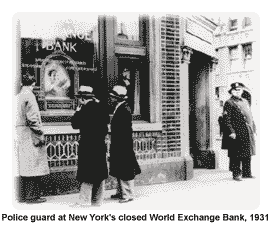 Previous to the 1929 collapse, business had begun to falter. Following the crash, the United States continued to decline steadily into the most profound depression of its history. Banks failed, millions of citizens suddenly had no savings. Factories locked their gates, shops were shuttered forever, and most remaining businesses struggled to survive. Local governments faced great difficulty with collecting taxes to keep services going.
Previous to the 1929 collapse, business had begun to falter. Following the crash, the United States continued to decline steadily into the most profound depression of its history. Banks failed, millions of citizens suddenly had no savings. Factories locked their gates, shops were shuttered forever, and most remaining businesses struggled to survive. Local governments faced great difficulty with collecting taxes to keep services going.
Hoover`s administration made a bad mistake when Congress, caving in to special interests, passed the Smoot-Hawley Tariff Act in 1930. The measure would hike up tariffs to prohibitively high levels. The president signed the bill into law over the objections of more than 1,000 economists. Every major trading nation protested against the law and many immediately retaliated by raising their tariffs. The impacts on international trade were catastrophic. This and other effects caused international trade to grind nearly to a standstill; the depression spread worldwide.
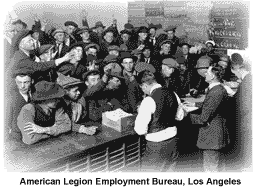 Meanwhile, the president and business leaders tried to convince the citizenry that recovery from the Great Depression was imminent, but the nation`s economic health steadily worsened. In spite of widespread hardship, Hoover maintained that federal relief was not necessary. Farm prices dropped to record lows and bitter farmers tried to ward off foreclosers with pitchforks. By the dawn of the next decade, 4,340,000 Americans were out of work. More than eight million were on the street a year later. Laid-off workers agitated for drastic government remedies. More than 32,000 other businesses went bankrupt and at least 5,000 banks failed. Wretched men, including veterans, looked for work, hawked apples on sidewalks, dined in soup kitchens, passed the time in shantytowns dubbed "Hoovervilles," and some moved between them in railroad boxcars. It was a desperate time for families, starvation stalked the land, and a great drought ruined numerous farms, forcing mass migration.
Meanwhile, the president and business leaders tried to convince the citizenry that recovery from the Great Depression was imminent, but the nation`s economic health steadily worsened. In spite of widespread hardship, Hoover maintained that federal relief was not necessary. Farm prices dropped to record lows and bitter farmers tried to ward off foreclosers with pitchforks. By the dawn of the next decade, 4,340,000 Americans were out of work. More than eight million were on the street a year later. Laid-off workers agitated for drastic government remedies. More than 32,000 other businesses went bankrupt and at least 5,000 banks failed. Wretched men, including veterans, looked for work, hawked apples on sidewalks, dined in soup kitchens, passed the time in shantytowns dubbed "Hoovervilles," and some moved between them in railroad boxcars. It was a desperate time for families, starvation stalked the land, and a great drought ruined numerous farms, forcing mass migration.
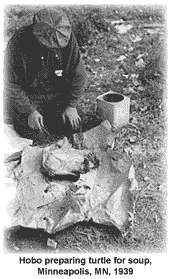 The Hoover administration attempted to respond by launching a road-, public-building, and airport-construction program, and increasing the country`s credit facilities, including strengthening the banking system. Most significantly, the administration established the Reconstruction Finance Corporation (RFC) with $2 billion to shore up overwhelmed banks, railroads, factories, and farmers.
The Hoover administration attempted to respond by launching a road-, public-building, and airport-construction program, and increasing the country`s credit facilities, including strengthening the banking system. Most significantly, the administration established the Reconstruction Finance Corporation (RFC) with $2 billion to shore up overwhelmed banks, railroads, factories, and farmers.
The actions taken signified, for the first time, the U.S. government`s willingness to assume responsibility for rescuing the economy by overt intervention in business affairs. Nevertheless, the Great Depression persisted throughout the nation. Unemployment Relief remained largely a local and private matter.
A thirst for change
The electorate clamored for changes. The Republicans renominated Hoover, probably feeling that they had no better choice than their deeply unpopular leader. The Democrats nominated Franklin D. Roosevelt. His energetic, confident campaign rhetoric promoted something specifically for "the forgotten man" — a "New Deal." Roosevelt went on to a decisive victory. At his inauguration in March 1933, Roosevelt declared in his lilting style, "Let me assert my firm belief that the only thing we have to fear is, fear itself — needless, unreasoning, unjustified terror which paralyzes needed efforts to convert retreat into advance."
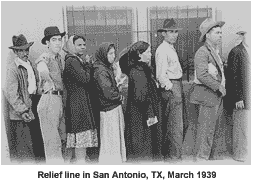 Congress passed a historic series of significant bills, most of which had originated in the White House, in just shy of a whirlwind 100 days. Congress also enacted several important relief and reform measures in the summer of 1935 — sometimes called the Second Hundred Days.
Congress passed a historic series of significant bills, most of which had originated in the White House, in just shy of a whirlwind 100 days. Congress also enacted several important relief and reform measures in the summer of 1935 — sometimes called the Second Hundred Days.
Significant legislation:
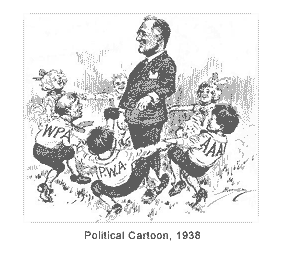 Progress was made on the labor front:
Progress was made on the labor front:
Relief, recovery and reform also affected the social welfare.
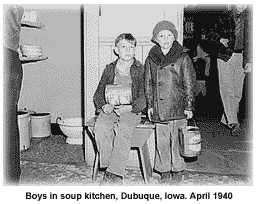 The U.S. government could reach out in the widest way to alleviate human misery from the Great Depression — such was the assumption implicit in the New Deal. Beginning in 1935, Congress enacted Social Security laws (and later amendments) that provided pensions to the aged, benefit payments to dependent mothers, crippled children and blind people, and unemployment insurance.
The U.S. government could reach out in the widest way to alleviate human misery from the Great Depression — such was the assumption implicit in the New Deal. Beginning in 1935, Congress enacted Social Security laws (and later amendments) that provided pensions to the aged, benefit payments to dependent mothers, crippled children and blind people, and unemployment insurance.
To fund all the new legislation, government spending rose. Spending in 1916 was $697 million; in 1936 it was $9 billion. The government modified taxes to tap wealthy people the most, who could take it in stride most easily. The rich, conservatives, numerous businessmen — and those who were all three — vigorously opposed the New Deal. But the election of 1936 triggered a nationwide endorsement of FDR, who carried every state except Vermont and Maine.
War looms
Franklin Roosevelt saw his domestic program inexorably superseded by war, much like a predecessor, Woodrow Wilson. The League of Nations had folded by the time FDR took office.
Clamoring for their perceived share of the world`s pie, Germany, Italy and Japan marched onto the world stage. Germany came under the sway of Adolf Hitler and his National Socialist Party. Italy embraced Benito Mussolini`s brand of fascism, and military rulers gripped Japan. Those leaders were warlike dictators committed to forging vast empires by armed might. When Japan invaded Manchuria in 1931 and China in 1937, free peoples recoiled. Italy goose stepped into Ethiopia in 1935. The Third Reich reoccupied the Rhineland in 1936 and absorbed Austria in 1938.
Isolationists believed the nation could remain aloof between the oceans, and most Americans went about their business trying to disregard the specter rising over the horizon. However, the president and his secretary of state, Cordell Hull, had no patience with Isolationism and repeatedly warned the nation that when one country was threatened by an imperial bully, all countries were threatened. In the fall of 1937, Roosevelt called for action to isolate the aggressive powers, but his words fell on a hard-of-hearing Congress and most of the public had their minds elsewhere.
In fact, Congress enacted several neutrality measures between 1935 and 1939 that prevented the nation from giving financial credit to, or trading with, any nation engaged in armed conflict. However, their effect was to invite aggression, because if Hitler struck at France or Great Britain, they could not hope for the United States to furnish them with arms or money.
To prevent the United States from entering the war in western Europe, which broke out when Hitler`s divisions invaded Poland in September 1939, isolationists established the "America First" Committee in 1940. However, administration leaders continued to condemn Germany and the other dictatorships. They strove to win Latin America`s and Canada`s friendship, and commenced to bolster the armed services.
Meanwhile, more Americans arrived at the notion that the United States might be next to fall under Germany`s sway if western Europe fell.
War transforms the nation`s economy
The United States had not fully put the economic woes of the Great Depression behind it by the time Japanese air and sea forces punched their fist through America`s back door at Pearl Harbor in December 1941.
Even near the end of the Great Depression, unemployment remained high. The 1940 census records still showed 11.1 percent of U.S. heads of household unemployed. However, a deep, latent productive capacity existed within American industry.
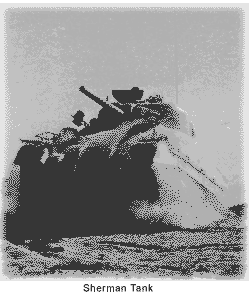 In anger, the nation swiftly changed gears from a peacetime to wartime footing that mobilized the populace and numerous industrial sectors. In January 1942, the president called for unheard-of production goals. In that year alone, he wanted 60,000 warplanes, 45,000 tanks, 20,000 antiaircraft guns and 18 million tons of merchant shipping.
In anger, the nation swiftly changed gears from a peacetime to wartime footing that mobilized the populace and numerous industrial sectors. In January 1942, the president called for unheard-of production goals. In that year alone, he wanted 60,000 warplanes, 45,000 tanks, 20,000 antiaircraft guns and 18 million tons of merchant shipping.
Labor, farms, mines, factories, trading houses, investment firms, communications — even cultural and educational institutions — were enlisted into the war effort. The nation accumulated big money and generated huge new industries to mass produce planes, ships, armored vehicles and numerous other items. Major population shifts occurred as people headed to new jobs.
The draft helped bring the armed forces of the United States to more than 15 million members. Approximately 65 million men and women were in uniform or worked in war-related jobs by the end of 1943.
Massive unemployment became a thing of the past and the Great Depression was swallowed up in the worldwide effort to defeat the Axis powers of Japan, Germany and Italy.